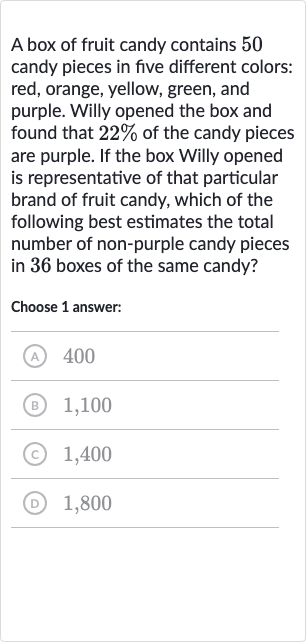AI tutor
Welcome to Bytelearn!
Let’s check out your problem:

A box of fruit candy contains candy pieces in five different colors: red, orange, yellow, green, and purple. Willy opened the box and found that of the candy pieces are purple. If the box Willy opened is representative of that particular brand of fruit candy, which of the following best estimates the total number of non-purple candy pieces in boxes of the same candy?Choose answer:(A) (B) ,(C) ,(D) ,
Full solution
Q. A box of fruit candy contains candy pieces in five different colors: red, orange, yellow, green, and purple. Willy opened the box and found that of the candy pieces are purple. If the box Willy opened is representative of that particular brand of fruit candy, which of the following best estimates the total number of non-purple candy pieces in boxes of the same candy?Choose answer:(A) (B) ,(C) ,(D) ,
- Calculate Percentage: Determine the percentage of non-purple candy pieces. Since of the candy pieces are purple, the percentage of non-purple candy pieces is .
- Calculate Candy Pieces: Calculate the number of non-purple candy pieces in one box.There are candy pieces in one box, so the number of non-purple candy pieces in one box is of .Number of non-purple candy pieces in one box = pieces.
- Calculate Total: Calculate the total number of non-purple candy pieces in boxes.Since there are non-purple candy pieces in one box, in boxes there would be non-purple candy pieces.Total number of non-purple candy pieces in boxes = pieces.
- Choose Best Estimate: Choose the best estimate from the given choices.The exact calculation gives us pieces, so the best estimate from the given choices is .
More problems from Experimental probability
QuestionGet tutor help
QuestionGet tutor help
QuestionGet tutor help
QuestionGet tutor help
QuestionGet tutor help
QuestionGet tutor help
QuestionGet tutor help
QuestionGet tutor help
QuestionGet tutor help


